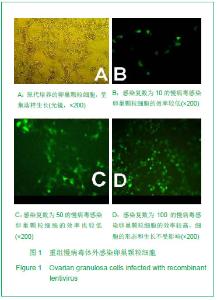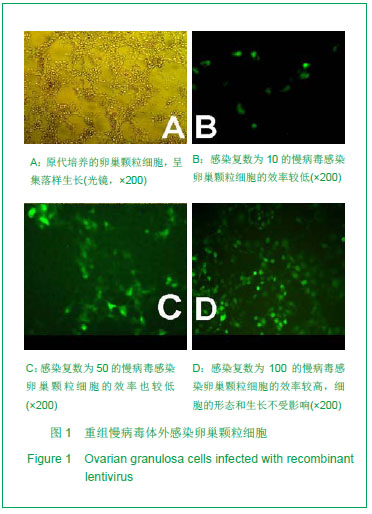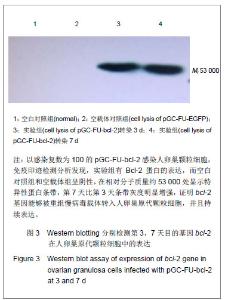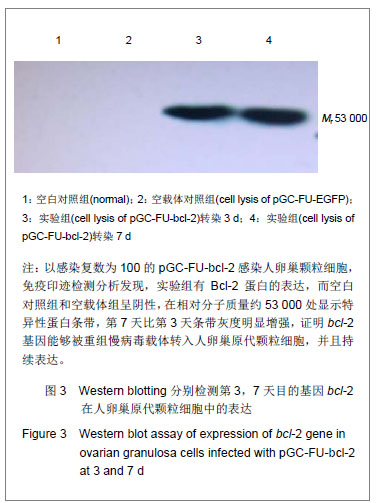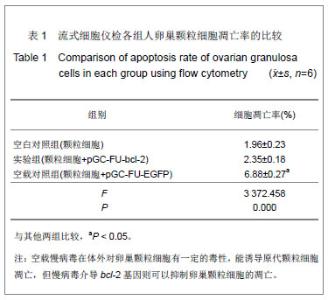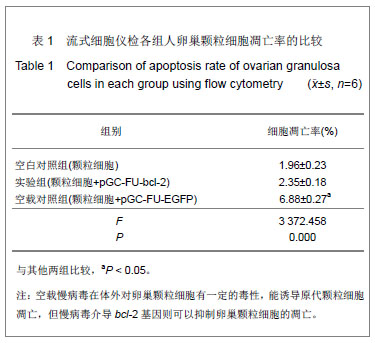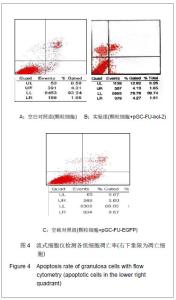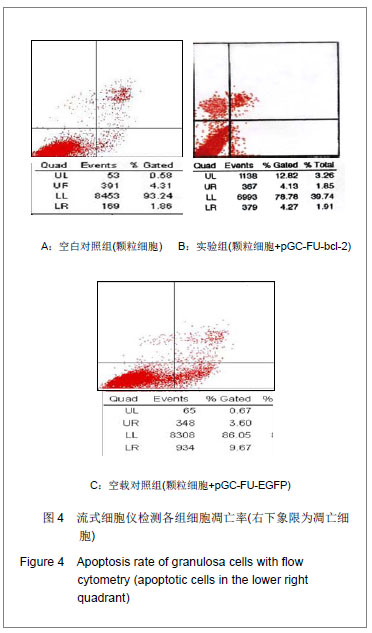Chinese Journal of Tissue Engineering Research ›› 2013, Vol. 17 ›› Issue (28): 5209-5215.doi: 10.3969/j.issn.2095-4344.2013.28.018
Previous Articles Next Articles
Apoptosis of human primary ovarian granulose cells infected with lentivirus carrying bcl-2 gene
Wang Xue-feng, Tan Feng, Chen Yan-ying, Liu Mu-biao, He Yuan-li
- Department of Gynaecology and Obstetrics, Zhujiang Hospital of Southern Medical University, Guangzhou 510282, Guangdong Province, China
-
Online:2013-07-09Published:2013-07-09 -
Contact:He Yuan-li, Master, Chief physician, Department of Gynaecology and Obstetrics, Zhujiang Hospital of Southern Medical University, Guangzhou 510282, Guangdong Province, China -
About author:Wang Xue-feng, M.D., Associate chief physician, Master’s supervisor, Department of Gynaecology and Obstetrics, Zhujiang Hospital of Southern Medical University, Guangzhou 510282, Guangdong Province, China douwangxuefeng@163.com -
Supported by:the National Natural Science Foundation of China in 2010, No. 81041101*;
the Natural Science Foundation of Guangdong Province in 2010, No. 10451051501004704*;
the Science and Technology Program of Guangzhou in 2011, No. 2011J4100087*
CLC Number:
Cite this article
Wang Xue-feng, Tan Feng, Chen Yan-ying, Liu Mu-biao, He Yuan-li. Apoptosis of human primary ovarian granulose cells infected with lentivirus carrying bcl-2 gene[J]. Chinese Journal of Tissue Engineering Research, 2013, 17(28): 5209-5215.
share this article
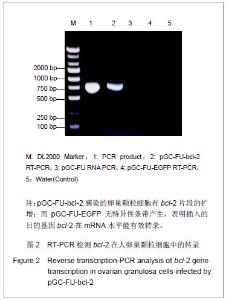
培养的卵巢颗粒细胞24 h即贴壁,集落样生长,呈多角形或梭形,见图1A。扩增纯化后获得的重组慢病毒pGC-FU-bcl-2及空载慢病毒pGC-FU-EGFP的滴度分别为5.06×1012 U/L和6.73×1012 U/L。采用不同感染复数感染卵巢颗粒细胞,培养24,48,72 h后在荧光显微镜下观察卵巢颗粒细胞的感染效率,结果可见:感染 24 h后,在荧光显微镜下可以看到EGFP的表达呈阳性,之后逐渐增强,至72 h后其绿色荧光的表达呈高峰。病毒感染复数分别为10,50时,慢病毒感染细胞的效率较低,见图1B,C,感染复数为100时,感染效率较高,且细胞的形态和生长不受影响,其在颗粒细胞中的阳性率达60%,见图1D。感染复数为200和400时,细胞病理现象明显,细胞变圆,漂浮,细胞的正常增殖受影响。因此,后续实验中的感染率及其余指标均在感染复数为100的条件下测定。 2.2 RT-PCR检测重组慢病毒pGC-FU-bcl-2中bcl-2基因的转录 用Trizol试剂盒提取感染重组慢病毒pGC-FU-bcl-2的卵巢颗粒细胞总RNA,经DNaseⅠ处理后行RT-PCR,并用RNA直接PCR和空载慢病毒pGC-FU-EGFP的cDNA产物作阴性对照。结果可见,pGC-FU-bcl-2感染的卵巢颗粒细胞有bcl-2片段的扩增;而pGC-FU-EGFP无特异性条带产生,表明插入的目的基因bcl-2在mRNA水平能有效转录,见图2。"
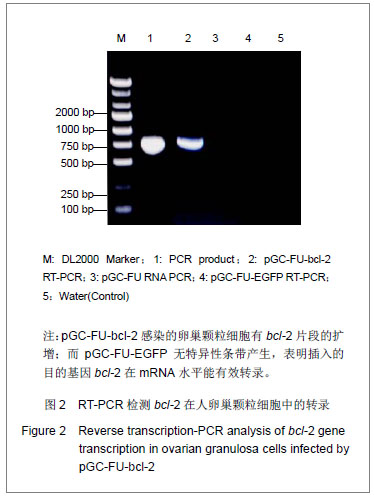
| [1]Maman E, Prokopis K, Levron J, et al. Does controlled ovarian stimulation prior to chemotherapy increase primordial follicle loss and diminish ovarian reserve? An animal study. Hum Reprod. 2009;24(1):206-210.[2]Lie Fong S, Lugtenburg PJ, Schipper I, et al. Anti-müllerian hormone as a marker of ovarian function in women after chemotherapy and radiotherapy for haematological malignancies. Hum Reprod. 2008;23(3):674-678.[3]Mathelin C, Brettes JP, Diemunsch P. Premature ovarian failure after chemotherapy for breast cancer.Bull Cancer. 2008;95(4):403-412.[4]Sasagawa S, Shimizu Y, Nagaoka T, et al. Dienogest, a selective progestin, reduces plasma estradiol level through induction of apoptosis of granulosa cells in the ovarian dominant follicle without follicle-stimulating hormone suppression in monkeys.J Endocrinol Invest. 2008;31(7):636-641.[5]Yuan P, Bartlam M, Lou Z,et al. Crystal structure of an avian influenza polymerase PA(N) reveals an endonuclease active site.Nature. 2009;458(7240):909-913.[6]王雪峰,何援利. 大鼠B细胞淋巴瘤-2基因的克隆及其慢病毒表达载体的构建[J].解放军医学杂志,2009,34(1):51-54.[7]郜虹媛,匡延平. IVF-ET中促性腺激素释放激素激动剂的超促排卵应用与剂量研究[J].生殖与避孕,2012,32(6):403-407. [8]王国鹏,罗凌惠,谢静,等.慢病毒载体和腺病毒载体转染原代培养的螺旋神经节细胞的比较[J].临床耳鼻咽喉头颈外科杂志,2011, 25(4):172-175. [9]陈彩云,刘亚京,牛忠英.慢病毒载体的研究进展及应用[J].口腔颌面修复学杂志,2012,13(2):117-120.[10]Engelbert D, Schnerch D, Baumgarten A,et al.The ubiquitin ligase APC(Cdh1) is required to maintain genome integrity in primary human cells.Oncogene. 2008;27(7):907-917.[11]Yew NS, Przybylska M, Ziegler RJ,et al. High and sustained transgene expression in vivo from plasmid vectors containing a hybrid ubiquitin promoter. Mol Ther. 2001;4(1):75-82.[12]Conaway RC, Brower CS, Conaway JW. Emerging roles of ubiquitin in transcription regulation. Science. 2002;296 (5571): 1254-1258.[13]Stanley BJ, Ehrlich ES, Short L,et al. Structural insight into the human immunodeficiency virus Vif SOCS box and its role in human E3 ubiquitin ligase assembly. J Virol. 2008;82(17): 8656-8663.[14]Böcker W, Rossmann O, Docheva D,et al. Quantitative polymerase chain reaction as a reliable method to determine functional lentiviral titer after ex vivo gene transfer in human mesenchymal stem cells.J Gene Med. 2007;9(7):585-595.[15]Wang YY, Yang Y, Chen Q,et al.Simultaneous knockdown of p18INK4C, p27Kip1 and MAD1 via RNA interference results in the expansion of long-term culture-initiating cells of murine bone marrow cells in vitro.Acta Biochim Biophys Sin (Shanghai). 2008;40(8):711-720.[16]杨萍,严金川,刘培晶.siRNA反向转染法提高原代悬浮细胞转染效率的应用[J].江苏大学学报:医学版,2010,20(3):267-269.[17]李华玲,周晓霞.阳离子脂质体转染人类骨骼肌原代细胞的初步研究[J].生物学杂志,2006,23(6):8-10.[18]张余琴,林晓琳,贾俊双,等. 红色荧光蛋白和荧光素酶双报告基因转基因小鼠的建立[J].中国癌症杂志,2012,22(5):321-328.[19]王露露,刘勤,周晓杨,等.慢病毒介导HLA-G转基因小鼠的建立[J]. 第三军医大学学报,2012,34(14):1392-1396.[20]Monniaux D. Oocyte apoptosis and evolution of ovarian reserve. Gynecol Obstet Fertil. 2002;30(10):822-826.[21]Wang X, Wang Y, Kim HP, et al. Carbon monoxide protects against hyperoxia-induced endothelial cell apoptosis by inhibiting reactive oxygen species formation.J Biol Chem. 2007;282(3):1718-1726.[22]Rho GJ, Kim DS. Influence of in vitro oxygen concentrations on preimplantation embryo development, gene expression and production of Hanwoo calves following embryo transfer. Mol Reprod Dev. 2007;74(4):486-496.[23]Gupta MK, Uhm SJ, Han DW, et al. Embryo quality and production efficiency of porcine parthenotes is improved by phytohemagglutinin. Mol Reprod Dev. 2007;74(4):435-444..[24]孙懿,胡志德,黄元兰,等. IL-22抑制ox-LDL诱导的CRL-1730细胞凋亡并上调其Bcl-2表达[J].第二军医大学学报,2011,32(3): 233-237.[25]朱华,胡燕,帅茨霞,等. survivin、bcl-2在宫颈癌和癌前病变组织中的表达及与人乳头瘤病毒16/18感染的相关性[J]. 中华医学杂志,2010,90(7):469-473.[26]Wang X, Wang Y, Kim HP,et al. Carbon monoxide protects against hyperoxia-induced endothelial cell apoptosis by inhibiting reactive oxygen species formation.J Biol Chem. 2007;282(3):1718-1726.[27]Orike N, Middleton G, Borthwick E,et al. Role of PI 3-kinase, Akt and Bcl-2-related proteins in sustaining the survival of neurotrophic factor-independent adult sympathetic neurons.J Cell Biol. 2001;154(5):995-1005.[28]Vairo G, Innes KM, Adams JM. Bcl-2 has a cell cycle inhibitory function separable from its enhancement of cell survival. Oncogene. 1996;13(7):1511-1519.[29]Baghdassarian N, Bertrand Y, Ffrench P,et al. Role of BCL-2 and cell cycle regulatory proteins for corticosensitivity assessment in childhood acute lymphoblastic leukaemia. Br J Haematol. 2000;109(1):109-116.[30]Zhou W, Liu J, Liao L,et al. Effect of bisphenol A on steroid hormone production in rat ovarian theca-interstitial and granulosa cells.Mol Cell Endocrinol. 2008;283(1-2):12-18.[31]Aerts JM, De Clercq JB, Andries S,et al. Follicle survival and growth to antral stages in short-term murine ovarian cortical transplants after Cryologic solid surface vitrification or slow-rate freezing.Cryobiology. 2008;57(2):163-169.[32]Aerts JM, Bols PE. Ovarian follicular dynamics: a review with emphasis on the bovine species. Part I: Folliculogenesis and pre-antral follicle development. Reprod Domest Anim. 2010; 45(1):171-179.[33]Santos HB, Thomé RG, Arantes FP,et al. Ovarian follicular atresia is mediated by heterophagy, autophagy, and apoptosis in Prochilodus argenteus and Leporinus taeniatus (Teleostei: Characiformes).Theriogenology. 2008;70(9): 1449-1460.[34]Chitnis SS, Navlakhe RM, Shinde GC,et al. Granulosa cell apoptosis induced by a novel FSH binding inhibitory peptide from human ovarian follicular fluid. J Histochem Cytochem. 2008;56(11):961-968.[35]Yu YS, Sui HS, Han ZB,et al. Apoptosis in granulosa cells during follicular atresia: relationship with steroids and insulin-like growth factors.Cell Res. 2004;14(4):341-346.[36]Tilly JL, Tilly KI, Kenton ML,et al. Expression of members of the bcl-2 gene family in the immature rat ovary: equine chorionic gonadotropin-mediated inhibition of granulosa cell apoptosis is associated with decreased bax and constitutive bcl-2 and bcl-xlong messenger ribonucleic acid levels. Endocrinology. 1995;136(1):232-241.[37]Choi D, Hwang S, Lee E,et al. Expression of mitochondria-dependent apoptosis genes (p53, Bax, and Bcl-2) in rat granulosa cells during follicular development.J Soc Gynecol Investig. 2004;11(5):311-317.[38]Yoshida Y, Hosokawa K, Dantes A,et al. Theophylline and cisplatin synergize in down regulation of BCL-2 induction of apoptosis in human granulosa cells transformed by a mutated p53 (p53 val135) and Ha-ras oncogene.Int J Oncol. 2000; 17(2):227-235.[39]姜勋平,周东蕊,杨利国,等.鸡Bcl-2基因的克隆及其对卵泡颗粒细胞凋亡的影响[J].中国兽医学报,2002,22(1):87-89. |
| [1] | Geng Qiudong, Ge Haiya, Wang Heming, Li Nan. Role and mechanism of Guilu Erxianjiao in treatment of osteoarthritis based on network pharmacology [J]. Chinese Journal of Tissue Engineering Research, 2021, 25(8): 1229-1236. |
| [2] | Chen Junyi, Wang Ning, Peng Chengfei, Zhu Lunjing, Duan Jiangtao, Wang Ye, Bei Chaoyong. Decalcified bone matrix and lentivirus-mediated silencing of P75 neurotrophin receptor transfected bone marrow mesenchymal stem cells to construct tissue-engineered bone [J]. Chinese Journal of Tissue Engineering Research, 2021, 25(4): 510-515. |
| [3] | Zuo Zhenkui, Han Jiarui, Ji Shuling, He Lulu. Pretreatment with ginkgo biloba extract 50 alleviates radiation-induced acute intestinal injury in mice [J]. Chinese Journal of Tissue Engineering Research, 2021, 25(23): 3666-3671. |
| [4] | Yan Xiurui, Tao Jin, Liang Xueyun. Mechanism by which exosomes from human fetal placental mesenchymal stem cells protect lung epithelial cells against oxidative stress injury [J]. Chinese Journal of Tissue Engineering Research, 2021, 25(19): 2994-2999. |
| [5] | Dai Yaling, Chen Lewen, He Xiaojun, Lin Huawei, Jia Weiwei, Chen Lidian, Tao Jing, Liu Weilin. Construction of miR-146b overexpression lentiviral vector and the effect on the proliferation of hippocampal neural stem cells [J]. Chinese Journal of Tissue Engineering Research, 2021, 25(19): 3024-3030. |
| [6] | Zhao Shuangdan, Zheng Jiahua, Qi Wenbo, Huang Xianghua. Role and mechanism of exosomes derived from mesenchymal stem cells in reproductive system diseases [J]. Chinese Journal of Tissue Engineering Research, 2021, 25(19): 3097-3102. |
| [7] | Xian Guoyan, Chen Weishen, Zhang Ziji, Ye Yongyu, Pan Baiqi, Zheng Linli, Sheng Puyi. Construction of a stable Atg5 gene knockdown cell line in RAW 264.7 cells by lentivirus infection [J]. Chinese Journal of Tissue Engineering Research, 2021, 25(1): 84-89. |
| [8] | Zhao Chuntao, Qing Mingsong, Yu Langbo, Peng Jiachen . Meta-analysis of total knee arthroplasty guided by kinematic alignment and mechanical alignment [J]. Chinese Journal of Tissue Engineering Research, 2020, 24(9): 1435-1442. |
| [9] |
Peng Xu, Yang Jibin, You Qi, Jin Ying, Zhang Jun, Ge Zhen, Zou Gang, Jiang Kongjun, Liu Yi.
Effect of Psammosilene gavage on the expression of
apoptosis-related proteins in chondrocytes of a rabbit osteoarthritis model |
| [10] |
Zhang Cong, Zhao Yan, Du Xiaoyu, Du Xinrui, Pang Tingjuan, Fu Yining, Zhang Hao, Zhang Buzhou, Li Xiaohe, Wang Lidong.
Biomechanical analysis of the lumbar spine and pelvis in adolescent
idiopathic scoliosis with lumbar major curve |
| [11] | Xu Guofeng, Li Xuebin, Tang Yifan, Zhao Yin, Zhou Shengyuan, Chen Xiongsheng, Jia Lianshun. The role of autophagy in ossification of the human ligamentum flavum [J]. Chinese Journal of Tissue Engineering Research, 2020, 24(8): 1174-1181. |
| [12] | Huang Yongming, Huang Qiming, Liu Yanjie, Wang Jun, Cao Zhenwu, Tian Zhenjiang, Chen Bojian, Mai Xiujun, Feng Enhui. Proliferation and apoptosis of chondrocytes co-cultured with TDP43 lentivirus transfected-human umbilical cord mesenchymal stem cells [J]. Chinese Journal of Tissue Engineering Research, 2020, 24(7): 1016-1022. |
| [13] |
Cen Yanhui, Xia Meng, Jia Wei, Luo Weisheng, Lin Jiang, Chen Songlin, Chen Wei, Liu Peng, Li Mingxing, Li Jingyun, Li Manli, Ai Dingding, Jiang Yunxia.
Baicalein inhibits the biological behavior of hepatocellular
carcinoma stem cells by downregulation of Decoy receptor 3 expression |
| [14] | He Yujie, Wang Haiyan, Li Zhijun, Li Xiaohe, Cai Yongqiang, Dai Lina, Xu Yangyang, Wang Yidan, Xu Xuebin. Digital measurements of the anatomical parameters of pedicle-rib unit screw fixation in thoracic vertebrae of preschoolers [J]. Chinese Journal of Tissue Engineering Research, 2020, 24(6): 869-876. |
| [15] | Yan Shu, Lu Yan, Ouyang Zhaolian. Analysis of programs on tissue engineering funded by the National Natural Science Foundation of China between 2013 and 2018 [J]. Chinese Journal of Tissue Engineering Research, 2020, 24(5): 731-735. |
| Viewed | ||||||
|
Full text |
|
|||||
|
Abstract |
|
|||||
